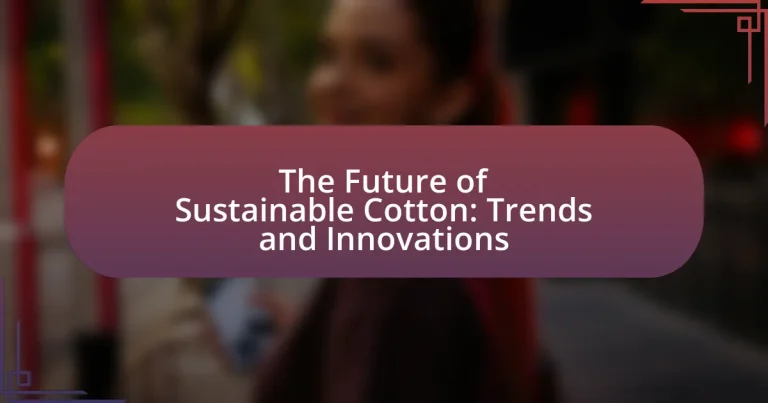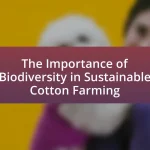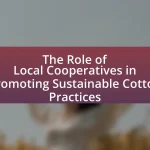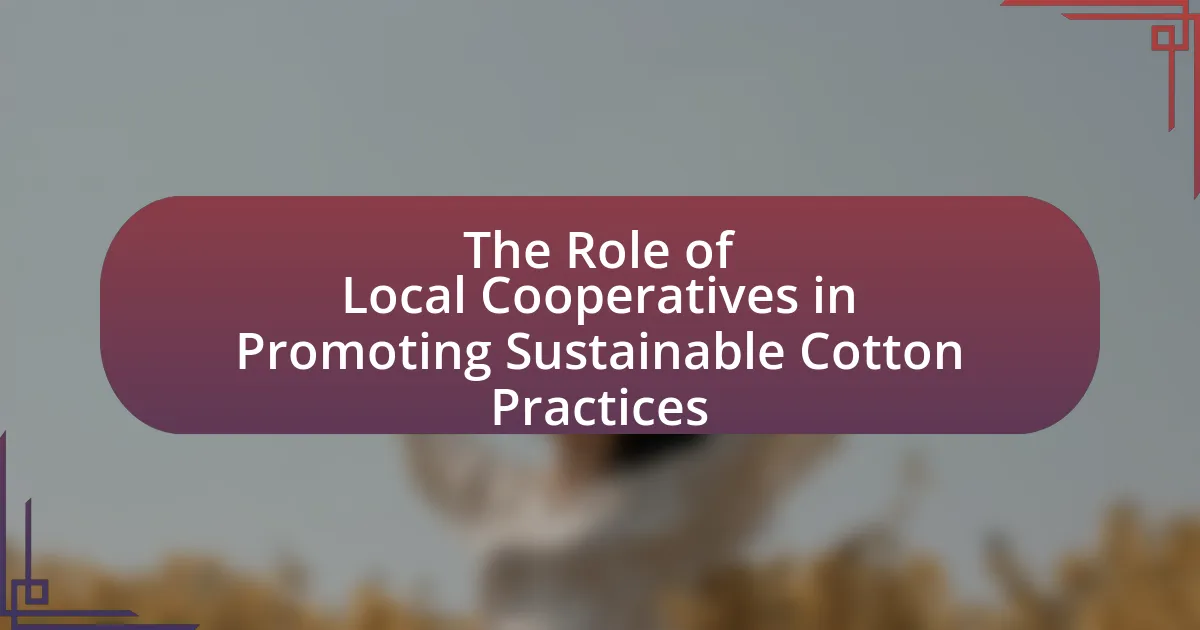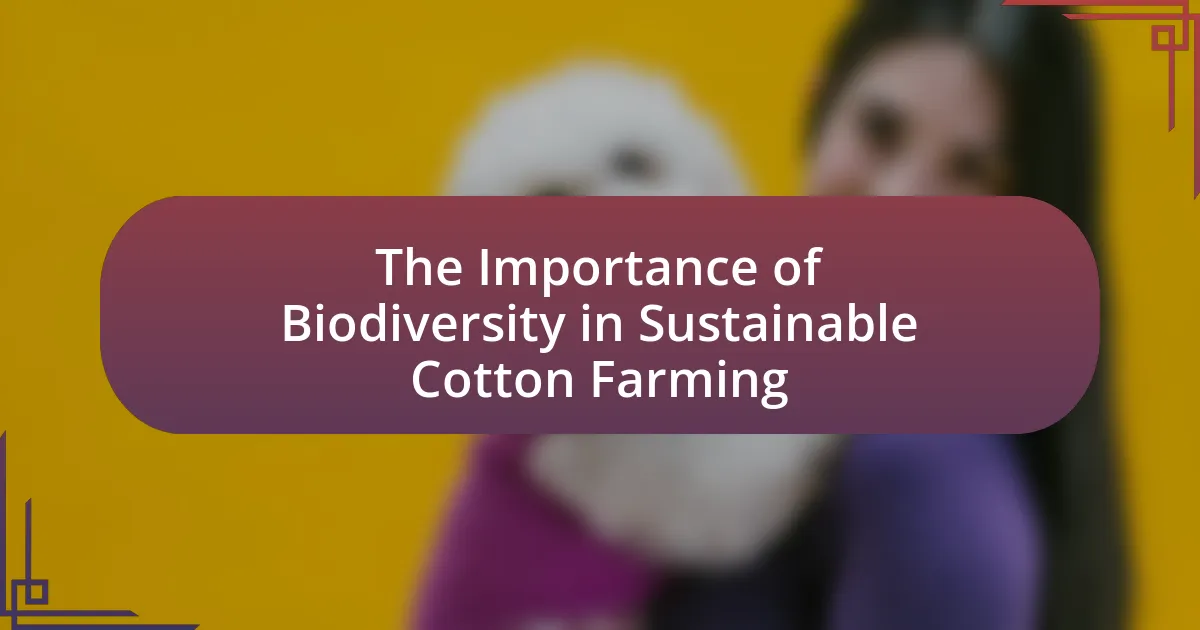The article focuses on the future of sustainable cotton, highlighting trends and innovations that are shaping the industry. It defines sustainable cotton as cotton produced through environmentally friendly practices that minimize ecological harm and promote social responsibility. Key characteristics include reduced chemical usage, fair labor practices, and significant water conservation. The article discusses the growing consumer demand for sustainable textiles, the role of certifications in ensuring compliance with environmental and social standards, and the impact of technological advancements on sustainable cotton farming. Additionally, it addresses the challenges faced by the industry and the implications for the fashion sector, emphasizing the importance of sustainable cotton in achieving global sustainability goals.
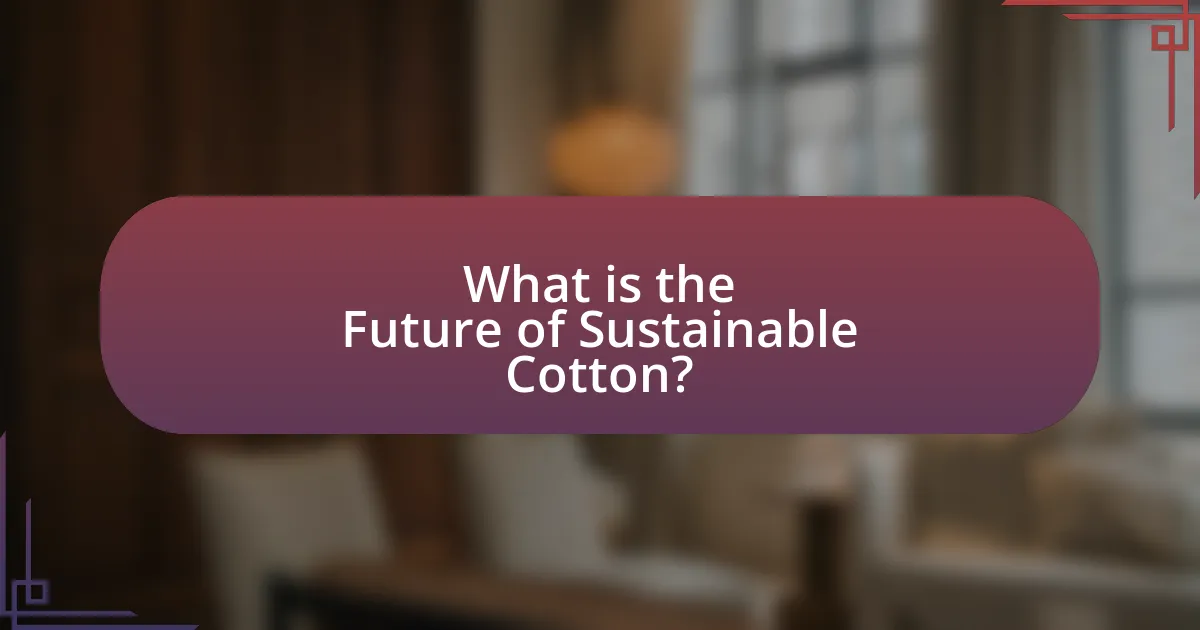
What is the Future of Sustainable Cotton?
The future of sustainable cotton is poised for significant growth driven by innovations in agricultural practices, consumer demand for eco-friendly products, and advancements in technology. Sustainable cotton farming is increasingly adopting regenerative agriculture techniques, which enhance soil health and biodiversity while reducing water usage and chemical inputs. According to the Textile Exchange’s 2021 report, the global market for organic cotton is projected to grow by 20% annually, reflecting a rising consumer preference for sustainable textiles. Additionally, innovations such as water-efficient irrigation systems and genetically modified cotton varieties that require fewer resources are expected to further enhance sustainability in cotton production. These trends indicate a strong trajectory towards a more sustainable cotton industry, aligning with global sustainability goals.
How is sustainable cotton defined in today’s context?
Sustainable cotton is defined as cotton produced with environmentally friendly practices that minimize harm to ecosystems and promote social responsibility. This includes methods such as organic farming, which avoids synthetic pesticides and fertilizers, and practices that ensure fair labor conditions for workers. According to the Global Organic Textile Standard (GOTS), sustainable cotton must meet specific criteria regarding organic farming, ecological processing, and social compliance, ensuring that both environmental and social aspects are addressed in its production.
What are the key characteristics of sustainable cotton?
Sustainable cotton is characterized by environmentally friendly farming practices, reduced chemical usage, and social responsibility. These practices include organic farming methods that avoid synthetic pesticides and fertilizers, promoting biodiversity and soil health. Additionally, sustainable cotton production often involves fair labor practices, ensuring that workers receive fair wages and safe working conditions. According to the Global Organic Textile Standard, sustainable cotton farming can reduce water usage by up to 90% compared to conventional methods, highlighting its efficiency and ecological benefits.
Why is sustainable cotton important for the environment?
Sustainable cotton is important for the environment because it reduces harmful agricultural practices that contribute to soil degradation, water scarcity, and pesticide pollution. Conventional cotton farming often relies on synthetic fertilizers and pesticides, which can contaminate water sources and harm biodiversity. In contrast, sustainable cotton practices, such as organic farming and integrated pest management, promote healthier ecosystems by using natural inputs and reducing chemical runoff. According to the Textile Exchange, sustainable cotton farming can use up to 91% less water compared to conventional methods, significantly alleviating water stress in cotton-growing regions.
What are the current trends in sustainable cotton production?
Current trends in sustainable cotton production include the adoption of regenerative agriculture practices, increased use of organic farming methods, and the implementation of technology for better resource management. Regenerative agriculture focuses on improving soil health and biodiversity, which enhances cotton yield while reducing chemical inputs. Organic cotton production has seen a rise, with a reported 10% increase in global organic cotton area from 2019 to 2020, reflecting consumer demand for eco-friendly products. Additionally, precision agriculture technologies, such as drones and data analytics, are being utilized to optimize water usage and minimize pesticide application, contributing to more sustainable practices in the industry.
How are consumer preferences influencing sustainable cotton trends?
Consumer preferences are significantly influencing sustainable cotton trends by driving demand for eco-friendly and ethically produced textiles. As consumers increasingly prioritize sustainability, brands are responding by adopting organic cotton farming practices and transparent supply chains. For instance, a 2021 survey by McKinsey & Company found that 67% of consumers consider sustainability when making a purchase, leading to a rise in brands offering certified organic cotton products. This shift not only reflects consumer values but also encourages innovation in sustainable farming techniques and materials, ultimately shaping the future of the cotton industry.
What role do certifications play in sustainable cotton production?
Certifications play a crucial role in sustainable cotton production by ensuring adherence to environmental and social standards. These certifications, such as Global Organic Textile Standard (GOTS) and Better Cotton Initiative (BCI), provide a framework for farmers and producers to follow sustainable practices, including reduced pesticide use and improved water management. For instance, GOTS-certified cotton must meet strict criteria regarding organic farming practices, which can lead to a decrease in harmful chemical usage by up to 90%. Additionally, certifications enhance market access for producers, as consumers increasingly prefer sustainably sourced products, thereby driving demand for certified cotton.
What innovations are shaping the future of sustainable cotton?
Innovations shaping the future of sustainable cotton include the development of organic farming practices, biotechnology advancements, and water-efficient irrigation systems. Organic farming practices reduce chemical inputs, promoting soil health and biodiversity, while biotechnology advancements, such as genetically modified cotton that requires fewer pesticides, enhance crop resilience. Additionally, water-efficient irrigation systems, like drip irrigation, significantly lower water usage, addressing the critical issue of water scarcity in cotton production. These innovations collectively contribute to a more sustainable cotton industry by minimizing environmental impact and improving resource efficiency.
How is technology being utilized in sustainable cotton farming?
Technology is utilized in sustainable cotton farming through precision agriculture, which employs data analytics, sensors, and drones to optimize resource use and minimize environmental impact. For instance, soil moisture sensors provide real-time data, allowing farmers to irrigate only when necessary, thus conserving water. Additionally, drones equipped with imaging technology can monitor crop health and identify pest infestations early, reducing the need for chemical pesticides. According to a study by the International Cotton Advisory Committee, the adoption of these technologies can lead to a 20% increase in yield while decreasing water usage by up to 30%. This integration of technology not only enhances productivity but also supports eco-friendly practices in cotton farming.
What are the latest advancements in sustainable cotton processing?
Recent advancements in sustainable cotton processing include the development of water-efficient cultivation techniques and the use of organic fertilizers. These innovations significantly reduce water usage and chemical inputs, promoting environmental sustainability. For instance, the implementation of precision agriculture technologies allows farmers to optimize water and nutrient application, leading to a reported 30% reduction in water consumption in some regions. Additionally, the adoption of regenerative agricultural practices, such as crop rotation and cover cropping, enhances soil health and biodiversity, further supporting sustainable cotton production.
How do economic factors impact the future of sustainable cotton?
Economic factors significantly influence the future of sustainable cotton by affecting production costs, market demand, and investment in sustainable practices. For instance, rising labor costs and the increasing price of organic inputs can lead to higher production costs for sustainable cotton, potentially reducing its competitiveness against conventional cotton. Additionally, consumer demand for sustainable products is growing, with a report from the Global Organic Textile Standard indicating a 20% increase in organic cotton production from 2018 to 2019, which suggests a positive market trend for sustainable cotton. Furthermore, economic incentives, such as subsidies for sustainable farming practices, can encourage farmers to adopt eco-friendly methods, thereby shaping the future landscape of sustainable cotton production.
What challenges does the sustainable cotton industry face?
The sustainable cotton industry faces significant challenges, including water scarcity, pest management, and market competition. Water scarcity affects cotton production, as conventional cotton farming consumes large amounts of water, leading to environmental stress in regions where water is limited. Pest management is another challenge, as sustainable practices often rely on natural pest control methods, which can be less effective than chemical pesticides, potentially reducing yields. Additionally, market competition from cheaper, non-sustainable cotton can undermine the economic viability of sustainable practices, making it difficult for farmers to transition to more environmentally friendly methods. These challenges highlight the complexities involved in promoting sustainable cotton production while ensuring economic sustainability for farmers.
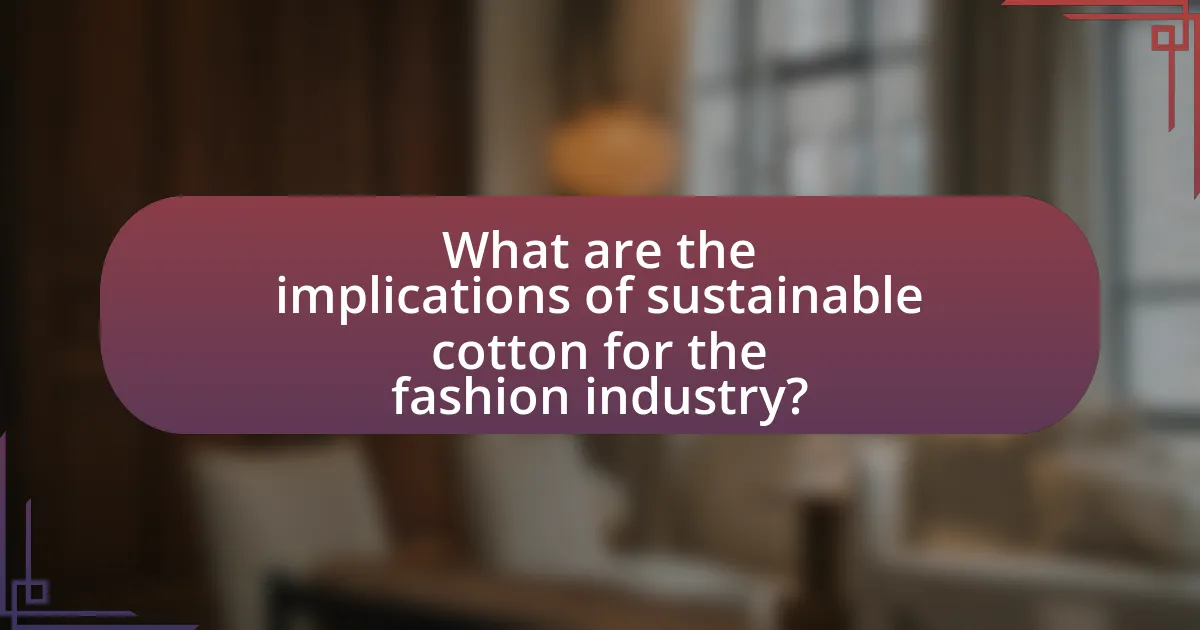
What are the implications of sustainable cotton for the fashion industry?
Sustainable cotton significantly impacts the fashion industry by promoting environmentally friendly practices and reducing resource consumption. The adoption of sustainable cotton leads to lower water usage, as it requires up to 90% less water compared to conventional cotton farming, thereby conserving vital water resources. Additionally, sustainable cotton farming often employs organic methods that minimize pesticide use, which can enhance soil health and biodiversity.
Furthermore, brands that utilize sustainable cotton can improve their market positioning, as consumer demand for eco-friendly products continues to rise; a 2021 survey indicated that 66% of global consumers are willing to pay more for sustainable brands. This shift not only aligns with ethical consumerism but also encourages innovation in supply chains, fostering transparency and traceability. Overall, the implications of sustainable cotton for the fashion industry include enhanced environmental stewardship, improved brand loyalty, and a potential increase in profitability through sustainable practices.
How are brands adapting to the demand for sustainable cotton?
Brands are adapting to the demand for sustainable cotton by implementing eco-friendly sourcing practices and investing in sustainable supply chains. Many companies are now prioritizing organic cotton, which is grown without harmful pesticides and fertilizers, thereby reducing environmental impact. For instance, the Global Organic Textile Standard (GOTS) certifies organic cotton, ensuring that it meets strict environmental and social criteria. Additionally, brands are collaborating with organizations like the Better Cotton Initiative (BCI), which promotes sustainable cotton farming practices and aims to improve the livelihoods of cotton farmers. This shift is supported by consumer demand; a 2021 survey indicated that 66% of global consumers are willing to pay more for sustainable brands, highlighting the market’s trend towards sustainability.
What strategies are brands using to source sustainable cotton?
Brands are employing several strategies to source sustainable cotton, including partnerships with certified organizations, investment in regenerative agriculture, and the adoption of traceability technologies. For instance, many brands collaborate with the Better Cotton Initiative, which promotes sustainable farming practices and provides training to farmers, resulting in a more environmentally friendly cotton supply. Additionally, brands are increasingly investing in regenerative agriculture practices that restore soil health and biodiversity, which can lead to higher quality cotton production. Furthermore, the use of blockchain technology allows brands to trace the origin of their cotton, ensuring transparency and accountability in their supply chains. These strategies collectively contribute to a more sustainable cotton industry.
How does sustainable cotton affect brand reputation?
Sustainable cotton positively affects brand reputation by enhancing consumer trust and loyalty. Brands that adopt sustainable cotton practices demonstrate a commitment to environmental responsibility and ethical sourcing, which resonates with increasingly eco-conscious consumers. Research indicates that 66% of global consumers are willing to pay more for sustainable brands, highlighting the financial benefits of a strong reputation linked to sustainability. Furthermore, companies like Levi Strauss & Co. have reported improved brand perception and customer engagement after implementing sustainable cotton initiatives, showcasing the tangible impact on reputation.
What are the benefits of using sustainable cotton in fashion?
Sustainable cotton offers numerous benefits in fashion, primarily by reducing environmental impact and promoting ethical practices. This type of cotton is grown without harmful pesticides and synthetic fertilizers, which decreases soil and water pollution. Additionally, sustainable cotton farming often employs water-efficient practices, leading to a significant reduction in water usage—up to 90% less water compared to conventional cotton farming.
Moreover, sustainable cotton supports fair labor practices, ensuring that farmers receive fair wages and work in safe conditions. This ethical approach not only enhances the livelihoods of farmers but also appeals to consumers increasingly concerned about the origins of their clothing. According to the Global Organic Textile Standard, sustainable cotton can also contribute to biodiversity by maintaining healthier ecosystems.
In summary, the benefits of using sustainable cotton in fashion include reduced environmental harm, improved water efficiency, ethical labor practices, and enhanced biodiversity.
How does sustainable cotton contribute to ethical fashion practices?
Sustainable cotton significantly contributes to ethical fashion practices by promoting environmentally friendly farming methods and ensuring fair labor conditions. This type of cotton is grown without harmful pesticides and synthetic fertilizers, which reduces environmental degradation and supports biodiversity. Additionally, sustainable cotton farming often adheres to fair trade principles, ensuring that farmers receive fair wages and work in safe conditions. For instance, the Better Cotton Initiative, which promotes sustainable cotton production, reports that its practices can lead to a 30% reduction in water usage and improved livelihoods for farmers. Thus, sustainable cotton not only minimizes ecological impact but also fosters social equity within the fashion industry.
What impact does sustainable cotton have on consumer loyalty?
Sustainable cotton significantly enhances consumer loyalty by aligning with the values of environmentally conscious consumers. Research indicates that 66% of global consumers are willing to pay more for sustainable brands, demonstrating a direct correlation between sustainable practices and brand loyalty. Furthermore, brands that adopt sustainable cotton practices often experience increased customer retention rates, as consumers prefer to support companies that prioritize ethical sourcing and environmental responsibility. This trend is supported by a study from Nielsen, which found that 73% of millennials are willing to pay extra for sustainable offerings, reinforcing the idea that sustainable cotton can foster deeper connections between brands and their customers.
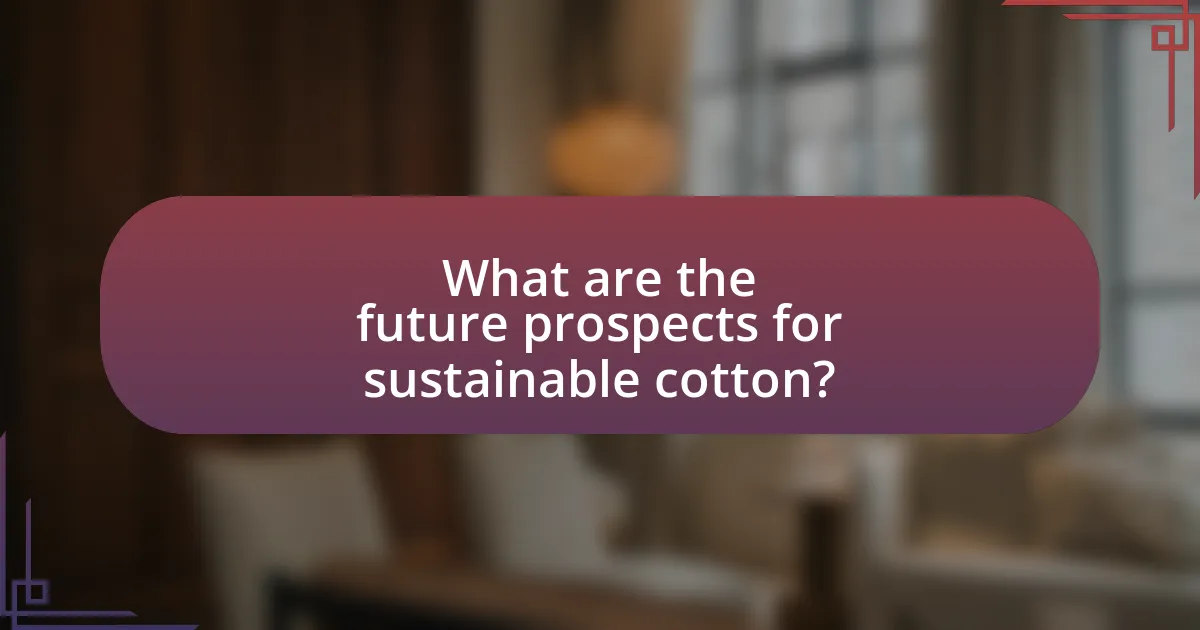
What are the future prospects for sustainable cotton?
The future prospects for sustainable cotton are promising, driven by increasing consumer demand for eco-friendly products and advancements in agricultural practices. Sustainable cotton production is projected to grow as brands and retailers prioritize sustainability in their supply chains, with initiatives like the Better Cotton Initiative aiming to improve environmental and social standards. According to a report by the Textile Exchange, the global market for organic cotton is expected to reach $1.5 billion by 2025, reflecting a significant shift towards sustainable practices. Additionally, innovations in biotechnology and regenerative agriculture are enhancing yield and reducing the environmental impact of cotton farming, further solidifying its future viability.
How can sustainable cotton contribute to global sustainability goals?
Sustainable cotton contributes to global sustainability goals by promoting environmentally friendly agricultural practices that reduce water usage, chemical inputs, and greenhouse gas emissions. For instance, organic cotton farming uses 91% less water compared to conventional methods, significantly conserving this vital resource. Additionally, sustainable cotton practices often involve crop rotation and integrated pest management, which enhance biodiversity and soil health. According to the Global Organic Textile Standard, sustainable cotton farming can reduce carbon emissions by up to 46% per kilogram of cotton produced, aligning with the United Nations Sustainable Development Goals aimed at climate action and responsible consumption.
What role does sustainable cotton play in combating climate change?
Sustainable cotton plays a crucial role in combating climate change by reducing greenhouse gas emissions and promoting biodiversity. The cultivation of sustainable cotton employs practices such as organic farming, crop rotation, and reduced pesticide use, which collectively lower carbon footprints. For instance, according to the Textile Exchange’s 2021 report, organic cotton farming can sequester up to 1.1 million tons of CO2 annually, demonstrating its potential impact on climate mitigation. Additionally, sustainable cotton farming enhances soil health and water conservation, further contributing to environmental resilience against climate change.
How can sustainable cotton practices be scaled globally?
Sustainable cotton practices can be scaled globally through the implementation of standardized certifications, collaborative partnerships, and technological innovations. Standardized certifications, such as the Better Cotton Initiative, provide a framework for farmers worldwide to adopt sustainable methods, ensuring consistency and accountability. Collaborative partnerships among governments, NGOs, and private sectors can facilitate knowledge sharing and resource allocation, enhancing the capacity of farmers in developing regions to transition to sustainable practices. Additionally, technological innovations, such as precision agriculture and blockchain for traceability, can optimize resource use and improve supply chain transparency, making sustainable cotton more accessible and appealing to consumers. These strategies collectively support the global scaling of sustainable cotton practices, as evidenced by the increasing adoption rates reported by organizations like the Better Cotton Initiative, which reached over 2.5 million farmers in 2020.
What practical steps can consumers take to support sustainable cotton?
Consumers can support sustainable cotton by choosing products made from certified organic or Fair Trade cotton. These certifications ensure that the cotton is grown without harmful pesticides and under fair labor conditions. According to the Global Organic Textile Standard, organic cotton farming uses 91% less water than conventional methods, highlighting its environmental benefits. Additionally, consumers can reduce their overall cotton consumption by opting for high-quality, durable items that last longer, thus minimizing waste. Supporting brands that prioritize sustainability in their supply chains also contributes to the demand for eco-friendly practices in cotton production.
